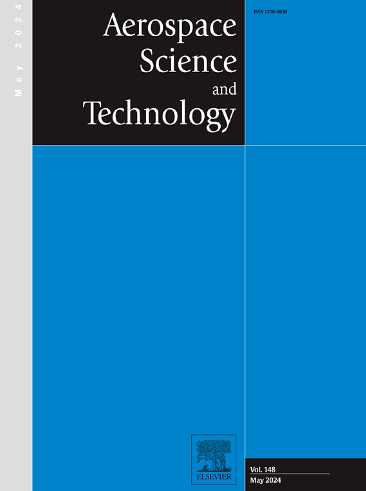设计带有初始弯曲梁的可变外倾角机翼后缘
IF 5
1区 工程技术
Q1 ENGINEERING, AEROSPACE
引用次数: 0
摘要
近年来,变弧度机翼(VCWs)因其在提高燃油效率、减少湍流和为未来飞机提供可调升阻比方面的优势而受到了全世界的广泛关注。尽管人们对VCWs的结构设计进行了许多尝试,但大变形、高承载能力的VCWs设计仍然缺乏。本研究提出了一种利用初始弯曲梁(ICBs)设计VCWs的新方法。通过对ICBs与直波束的符合性分析,可以明显看出ICBs比直波束提供更全面的符合性范围。利用icb的柔度特性,提出并参数化了一种VCW后缘结构。为了减小变形误差和变形后应力,建立了有限元模型,并采用遗传算法对截面几何形状和尺寸进行优化。制作了优化后的TE横截面原型。随后,进行了变弯度、数字图像相关(DIC)和承载实验,验证了变弯度的作用,测量了应力水平,评估了承载能力。实验结果与模拟结果吻合较好。5厘米宽的TE原型实现了±25°的可变倾角范围,最大应力为243 MPa,并且具有显著的变形精度。它的静态负载能力为10公斤。这些结果证实了利用icb设计具有大变形和高载荷能力的VCWs的可行性。本文章由计算机程序翻译,如有差异,请以英文原文为准。
Designing a variable camber wing trailing edge with initially curved beams
In recent years, variable camber wings (VCWs) have gained significant attention worldwide because of their advantages in improving fuel efficiency, reducing turbulence, and providing an adjustable lift-to-drag ratio for future aircraft. Although many attempts have been made to design the structure of VCWs, the design of VCWs with large deformations and high loading capacities remains lacking. This study proposes a novel method for designing VCWs by applying initially curved beams (ICBs). Through a compliance analysis of ICBs versus straight beams, it is evident that ICBs provide a more comprehensive compliance range than straight beams. Utilizing the compliance properties of ICBs, a VCW trailing edge (TE) structure was proposed and parameterized. To minimize deformation errors and post-deformation stress, finite element models were established, and a genetic algorithm was employed to optimize the cross-sectional geometry and dimensions. An optimized cross-sectional TE prototype was fabricated. Subsequently, experiments on the variable camber, digital image correlation (DIC), and load bearing were conducted to validate the function of the variable camber, measure the stress level, and assess the load-bearing capacity. The experimental results were consistent with those of the simulations. The 5 cm-wide TE prototype achieved the variable camber range of ±25° with a maximum stress of 243 MPa along with notable deformation accuracy. It has a static load capacity of 10 kg. These results confirmed the feasibility of designing VCWs capable of large deformations and high loading capacities, utilizing ICBs.
求助全文
通过发布文献求助,成功后即可免费获取论文全文。
去求助
来源期刊

Aerospace Science and Technology
工程技术-工程:宇航
CiteScore
10.30
自引率
28.60%
发文量
654
审稿时长
54 days
期刊介绍:
Aerospace Science and Technology publishes articles of outstanding scientific quality. Each article is reviewed by two referees. The journal welcomes papers from a wide range of countries. This journal publishes original papers, review articles and short communications related to all fields of aerospace research, fundamental and applied, potential applications of which are clearly related to:
• The design and the manufacture of aircraft, helicopters, missiles, launchers and satellites
• The control of their environment
• The study of various systems they are involved in, as supports or as targets.
Authors are invited to submit papers on new advances in the following topics to aerospace applications:
• Fluid dynamics
• Energetics and propulsion
• Materials and structures
• Flight mechanics
• Navigation, guidance and control
• Acoustics
• Optics
• Electromagnetism and radar
• Signal and image processing
• Information processing
• Data fusion
• Decision aid
• Human behaviour
• Robotics and intelligent systems
• Complex system engineering.
Etc.
 求助内容:
求助内容: 应助结果提醒方式:
应助结果提醒方式:


